Penguins are unique birds in that they do not fly. Their wings are adapted as swimming flippers by their wing bones being flattened and rather solidly joined so that they are very useful for swimming (up to 30 miles per hour). Penguins often look like they are flying when viewed under water.
 Most penguins spend the majority of their life at sea and return to land to reproduce. Getting to and from their reproductive areas (called rookeries) on land can be quite a walk but when there is snow to traverse, they often sled downhill to make quick descents.
Most penguins spend the majority of their life at sea and return to land to reproduce. Getting to and from their reproductive areas (called rookeries) on land can be quite a walk but when there is snow to traverse, they often sled downhill to make quick descents.On land, penguins walk (often in straight lines) to and from the ocean between their nesting colonies and their feeding grounds in the ocean (left). These trips can be only a few hundred yards over rocky beaches (like the picture above left) or they can be miles inland, often over snow and ice. Penguins tend to follow the same paths to and from the ocean to feed and bathe. When there is snow in their path they leave footprints (right).Most penguin species spend the year at sea without staying with their mate, returning each summer to their original breeding grounds and often to their original mate. The numbers of Antarctic penguins has been increasing over the years, a result perhaps of the decrease (from whaling) in the number of baleen whales visiting Antarctica. Without so many baleen whales (krill eaters) visiting Antarctica the krill population has increased and there is more food than ever before for the antarctic penguins.
Nest building - All but king and emperor penguins build a nest, though they are usually only a simple pile of stones that are continually stolen and swapped between the members of a colony. The nests are slightly higher than the surrounding land so that if the temperature rises and the snow melts, the nest is not flooded. Emperor and King penguins keep the egg and then the young chick on their feet covered by a brood pouch until they are large enough to regulate their own temperature.
Breeding Colonies - penguin colonies are very loud, raucous, busy and smelly affairs. The call of all penguins is as musical and gentle as a braying jackass and the whole colony is usually awash with penguin guano (posh word for bird poop). When I was in Antarctica one thing I did was help with long-term surveys which entailed walking through the colony (terribly frowned upon these days). Each nest is just over two pecking distances apart so the penguins can't reach each other. Of course walking through the middle meant that you were in range of everyone. I used to worry a lot about falling over in a penguin colony, covered from head to toe in guano and pecked mercilessly.
 Reproduction: Colonies may be of just a handful of breeding pairs or up to half a million birds and more. Many species lay two eggs, though it is rare that two chicks are raised, if food is short it will be fed to the biggest and strongest only. Male and female parents share egg and chick duty. Chicks are fed regurgitated fish and krill (yum!). The chicks leave the nest (or parents feet) when they are large enough to keep their own temperature constant, they form crèches to give each other mutual support and protection from marauding skuas and also to protect against the cold and wind.
Reproduction: Colonies may be of just a handful of breeding pairs or up to half a million birds and more. Many species lay two eggs, though it is rare that two chicks are raised, if food is short it will be fed to the biggest and strongest only. Male and female parents share egg and chick duty. Chicks are fed regurgitated fish and krill (yum!). The chicks leave the nest (or parents feet) when they are large enough to keep their own temperature constant, they form crèches to give each other mutual support and protection from marauding skuas and also to protect against the cold and wind.
No comments:
Post a Comment